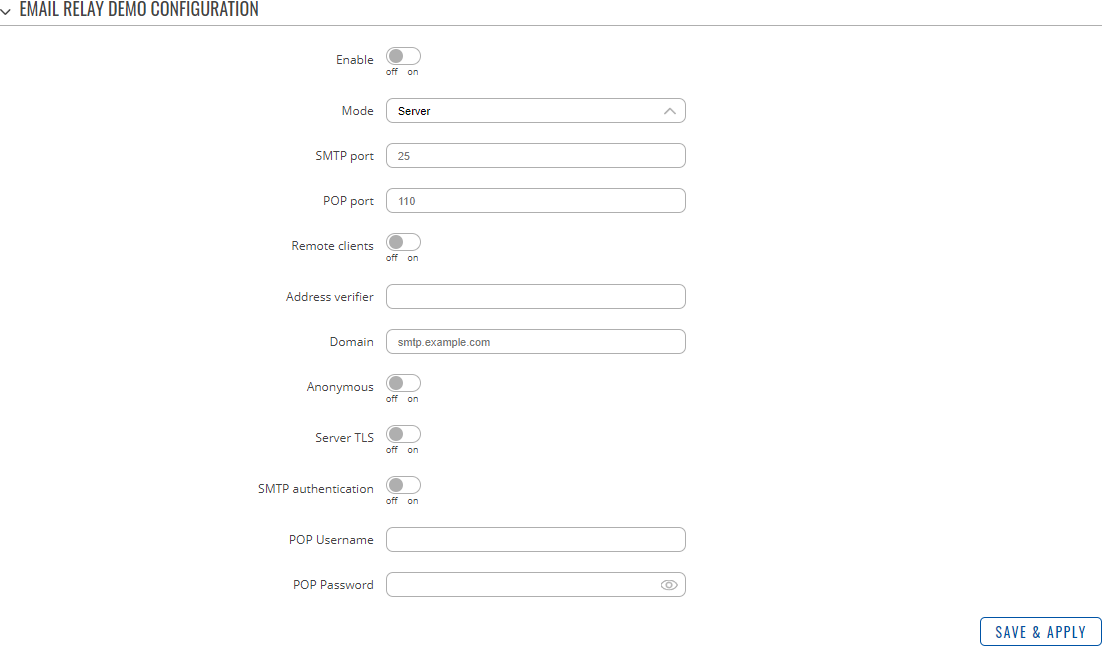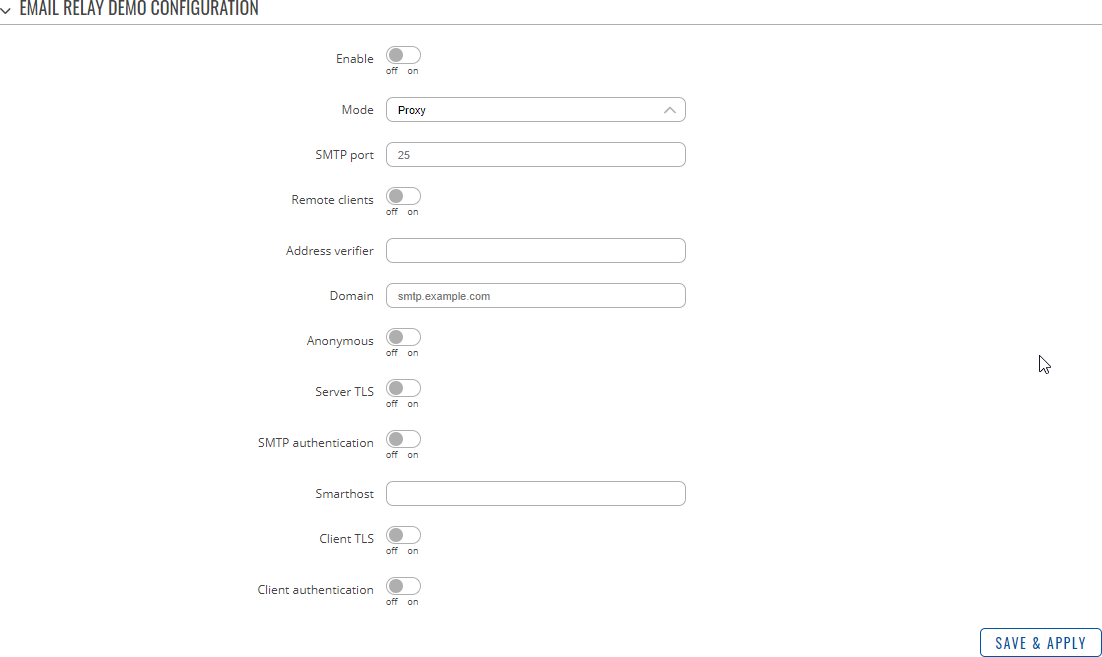RUT240 Email Relay: Difference between revisions
Appearance
Gytispieze (talk | contribs) Created page with "{{Template: Networking_rutos_manual_email_relay <!------------------------DEVICE-----------------------> | name = RUT240 | series = RUT2 <!----------------------SEPA..." |
No edit summary |
||
| Line 1: | Line 1: | ||
{{Template: | {{Template: Networking_rutos_manual_email_relay_rut2_rut9 | ||
<!------------------------DEVICE-----------------------> | <!------------------------DEVICE-----------------------> | ||
| name = RUT240 | | name = RUT240 | ||
Latest revision as of 09:34, 9 April 2024
Main Page > EOL Products > RUT240 > RUT240 Manual > RUT240 WebUI > RUT240 Services section > RUT240 Email RelayThe information in this page is updated in accordance with firmware version RUT2_R_00.07.06.19.
Summary
Email Relay is an e-mail store-and-forward message transfer agent and proxy server. The service does three things:
- Stores any incoming e-mail messages that it receives
- Forwards e-mail messages on to another remote e-mail server
- Serves up stored e-mail messages to local e-mail reader programs
More technically, it acts as a SMTP storage daemon, a SMTP forwarding agent, and a POP3 server.
This manual page provides an overview of the Email Relay functionality in RUT240 devices.
Note: Email Relay is additional software that can be installed from the System → Package Manager page.
Email Relay Configuration
This section displays Email Relays that are currently configured on the router. By default the list is empty. To add a new email relay, enter instance name, choose service mode and press 'Add'.
Server
| Field | Value | Description |
|---|---|---|
| Enable | off | on; default: off | Enables this email relay instance. |
| Mode | Server | Proxy | Command line; default: Server | Instance mode. |
| SMTP port | integer [1..65535]; default: none | SMTP Port to listen incoming connections. |
| POP port | integer [1..65535]; default: none | POP Port to listen incoming connections. |
| Remote clients | off | on; default: off | To allow connections from anywhere. By default only local allowed. |
| Address verifier | string; default: none | Runs the specified external program to verify a message recipient's e-mail address. |
| Domain | domain name; default: none | Specifies the network name that is used in SMTP EHLO. The default is derived from a DNS lookup of the local hostname. |
| Anonymous | off | on; default: off | Disables the server's SMTP VRFY command. |
| Server TLS | off | on; default: off | Enables TLS for incoming SMTP and POP connections. |
| TLS certificate | .pem certificate; default: none | Specifies a PEM-format file containing a X.509 certificate and private key. |
| SMTP authentication | off | on; default: off | Enables SMTP server authentication of remote SMTP clients. |
| SMTP Username | string; default: none | Username for authentication with the SMTP server. |
| SMTP Password | string; default: none | Password for authentication with the SMTP server. |
| POP Username | string; default: none | Username for authentication with the POP server. |
| POP Password | string; default: none | Password for authentication with the POP server. |
Proxy
| Field | Value | Description |
|---|---|---|
| Enable | off | on; default: off | Enables this email relay instance. |
| Mode | Server | Proxy | Command line; default: Server | Instance mode. |
| SMTP port | integer [1..65535]; default: none | SMTP Port to listen incoming connections. |
| Remote clients | off | on; default: off | To allow connections from anywhere. By default only local allowed. |
| Address verifier | string; default: none | Runs the specified external program to verify a message recipient's e-mail address. |
| Domain | domain name; default: none | Specifies the network name that is used in SMTP EHLO. The default is derived from a DNS lookup of the local hostname. |
| Anonymous | off | on; default: off | Disables the server's SMTP VRFY command. |
| Server TLS | off | on; default: off | Enables TLS for incoming SMTP and POP connections. |
| TLS certificate | .pem certificate; default: none | Specifies a PEM-format file containing a X.509 certificate and private key. |
| SMTP authentication | off | on; default: off | Enables SMTP server authentication of remote SMTP clients. |
| SMTP Username | string; default: none | Username for authentication with the SMTP server. |
| SMTP Password | string; default: none | Password for authentication with the SMTP server. |
| Smarthost | ip:port | domain name:port; default: none | Specify the SMTP to forward emails. |
| Client TLS | off | on; default: off | Enables negotiated TLS for outgoing SMTP connections. |
| Client authentication | off | on; default: off | Enables SMTP client authentication with the remote server. |
| Username | string; default: none | Username for authentication with the remote server. |
| Password | string; default: none | Password for authentication with the remote server. |
Command line
| Field | Value | Description |
|---|---|---|
| Enable | off | on; default: off | Enables this email relay instance. |
| Extra command line | string; default: none | Extra command line options. |




